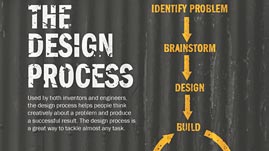Teachers' Domain - Digital Media for the Classroom and Professional Development
User: Preview


Source: DESIGN SQUAD



Engineers use a series of steps called the design process to solve a problem. The design process helps people think creatively about a problem and arrive at a successful solution, and is a great way to tackle almost any task. This printable image from DESIGN SQUAD outlines the five steps of the engineering design process: 1) identify the problem; 2) brainstorm; 3) design; 4) build, test, evaluate, and redesign; and 5) share solutions.This image is also available in Spanish.
Watch short videos in The Design Process Interactive to see each step of the engineering design process in action.
Share this resource with students to model how to think creatively and strengthen critical-thinking skills when solving problems.
After viewing, provide students with an engineering challenge. As they work through it, use the questions below to make connections to the steps of the engineering design process.
IDENTIFY THE PROBLEM
BRAINSTORM
DESIGN
BUILD, TEST, EVALUATE, AND REDESIGN
SHARE SOLUTIONS
 Loading Standards
Loading Standards